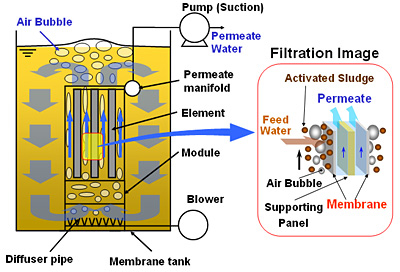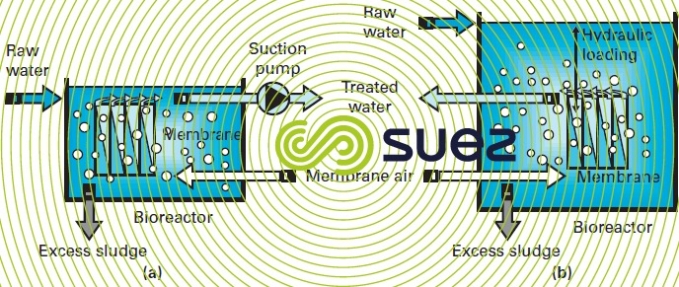Troubleshooting Common Issues with Membrane Bioreactor Systems
Troubleshooting Common Issues with Membrane Bioreactor Systems
Blog Article
Exactly How Membrane Bioreactors Are Reinventing Water Filtration Solutions
The emergence of membrane bioreactors (MBRs) represents a significant innovation in the area of water purification, combining biological treatment processes with innovative membrane filtering technologies. This combination not only improves the top quality of dealt with effluent but likewise addresses city space restraints, making MBRs particularly suitable for densely booming locations. As international water deficiency escalates, the duty of MBRs in helping with drinkable water reuse and lasting water management comes to be significantly critical. The implications of this modern technology extend past performance-- what obstacles and chances lie ahead for its prevalent application?
Introduction of Membrane Layer Bioreactors
Membrane bioreactors (MBRs) stand for a substantial development in water purification technology, as they combine organic therapy processes with membrane layer filtering. This integration boosts the performance of wastewater therapy by utilizing bacteria to degrade organic toxins while at the same time utilizing semi-permeable membrane layers to different cured water from suspended solids and pathogens.
The MBR system usually includes a biological activator where the microbial populace metabolizes impurities, followed by a membrane filtration unit that retains biomass and enables just tidy water to pass through. This dual performance causes greater effluent top quality compared to standard therapy methods. MBRs can be operated in both set and constant circulation modes, providing adaptability in style and application.
They also allow the recuperation of water for reuse, thus adding to water sustainability campaigns. In general, MBRs are at the center of improving water therapy performance and quality, showcasing the capacity for cutting-edge solutions in environmental administration.
Benefits of MBR Technology
The integration of biological therapy with membrane filtration supplies numerous advantages for water filtration procedures. Among the main advantages of Membrane Bioreactor (MBR) technology is its ability to effectively eliminate both organic and inorganic impurities, bring about top notch effluent. The membrane layers function as a physical obstacle, stopping put on hold solids and virus from going through, which enhances the general safety and reliability of treated water.
Furthermore, MBR systems call for a smaller footprint contrasted to conventional therapy methods, enabling for more efficient space usage. This small style is specifically advantageous in urban settings where land is restricted. MBRs likewise show functional adaptability, fitting differing influent qualities and circulation prices without substantial performance deterioration.
In addition, the process provides boosted nutrient elimination abilities, especially for nitrogen and phosphorus, which are critical for stopping eutrophication in receiving waters. The lowered sludge manufacturing linked with MBR modern technology also translates to reduce disposal expenses, making it a cost-effective remedy over time - Membrane Bioreactor. On the whole, the advantages of MBR technology setting it as a leading choice for sustainable and innovative water purification systems, resolving both ecological and economic worries
Applications in Water Purification
Applications of Membrane Bioreactor (MBR) modern technology in water filtration are diverse and impactful, dealing with various treatment requires across multiple markets. MBRs properly combine biological therapy processes with membrane filtering, about his making them suitable for municipal wastewater therapy, industrial effluent monitoring, and even safe and clean water reuse efforts.
In municipal setups, MBRs are increasingly used to improve the top quality of treated wastewater, permitting conformity with stringent discharge laws and helping with the recycling of water for watering and non-potable uses. Their compact style likewise makes them ideal for metropolitan atmospheres where area is limited.
Industrially, MBR modern technology is made use of to deal with process water and wastewater, specifically in industries such as food and beverage, drugs, and textiles. By efficiently removing contaminants and suspended solids, MBRs aid industries lessen ecological effects while recouping beneficial resources from wastewater streams.
In Addition, MBRs are obtaining grip in decentralized water treatment applications, where small systems can be deployed in remote areas or establishing regions. This adaptability allows neighborhoods to attain sustainable water management services, enhancing accessibility to clean water while minimizing reliance on conventional therapy methods.
Situation Researches and Success Stories

In an additional instance, a fabric production center in Bangladesh embraced MBR innovation to address its wastewater challenges. The system minimized chemical oxygen demand (COD) degrees from 1,200 mg/L to less than 100 mg/L, therefore satisfying regulative standards and dramatically lessening ecological impact.
The University of Cape Town's MBR installation has actually proven effective in treating greywater for non-potable reuse on campus. This project not only preserves potable water but additionally works as an educational model for lasting methods.
Moreover, a seafood handling plant in Norway made use of MBR innovation to deal with effluents including high levels of natural issue, attaining over 90% pollutant removal. These study highlight MBR technology's versatility and its crucial function in boosting water top quality throughout diverse applications.
Future of Water Treatment Solutions
As international water shortage and contamination challenges increase, ingenious water treatment remedies are ending up being progressively necessary to make sure sustainable access to clean water. The future of water therapy hinges on the combination of innovative innovations that enhance the performance and efficiency of purification processes. Membrane bioreactors (MBRs) go to the center of this development, combining organic therapy with membrane layer filtration to generate high-quality effluent suitable for different applications.

Emerging trends such as resource recuperation from wastewater, including nutrients and energy, will certainly additionally change treatment facilities into environmentally friendly centers. Advancements in nanotechnology and membrane layer materials assure enhanced performance and longevity of filtering systems.

Final Thought
Their role in safe and clean water reuse and sustainable water monitoring highlights their significance in attending to worldwide water shortage challenges. Proceeded study and growth will even more improve the effectiveness and adoption of MBR technology, ensuring a resistant future for water therapy remedies.
The emergence of membrane bioreactors (MBRs) represents a significant innovation in the field of water purification, merging biological therapy processes with cutting-edge membrane filtration innovations. As international water scarcity magnifies, the find more information duty of MBRs in helping with drinkable water reuse and sustainable water monitoring comes to be significantly crucial. They also enable the recovery of water for reuse, therefore adding to water sustainability campaigns.As worldwide water shortage and air pollution challenges intensify, cutting-edge water treatment options are coming to be progressively vital to ensure lasting accessibility to clean water. Their duty in safe and clean water reuse and lasting water administration highlights their importance in addressing international water shortage difficulties.
Report this page